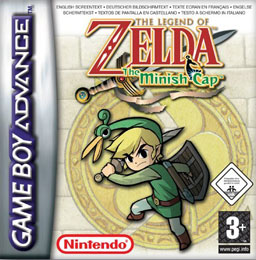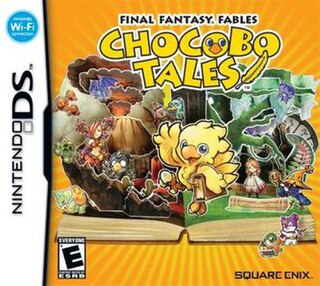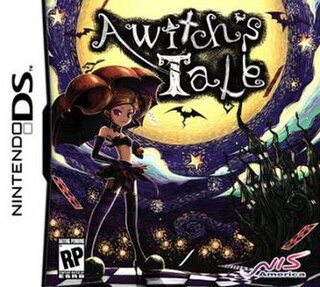
Final Fantasy IV, titled Final Fantasy II in its initial North American release, is a role-playing video game developed and published by Square for the Super Nintendo Entertainment System. Released in 1991, it is the fourth main installment of the Final Fantasy series. The game's story follows Cecil, a dark knight, as he tries to prevent the sorcerer Golbez from seizing powerful crystals and destroying the world. He is joined on this quest by a frequently changing group of allies. Final Fantasy IV introduced innovations that became staples of the Final Fantasy series and role-playing games in general. Its "Active Time Battle" system was used in five subsequent Final Fantasy games, and unlike prior games in the series, IV gave each character their own unchangeable character class — although at a few points in the story, a dark knight will choose the path of a paladin, or a summoner will evolve to a new tier of spellcasting.

The Mana series, known in Japan as Seiken Densetsu, is a high fantasy action role-playing game series created by Koichi Ishii, with development formerly from Square, and is currently owned by Square Enix. The series began in 1991 as Final Fantasy Adventure, a Game Boy handheld side story to Square's flagship franchise Final Fantasy. The Final Fantasy elements were subsequently dropped starting with the second installment, Secret of Mana, in order to become its own series. It has grown to include games of various genres within the fictional world of Mana, with recurring stories involving a world tree, its associated holy sword, and the fight against forces that would steal their power. Several character designs, creatures, and musical themes reappear frequently.

The Legend of Zelda: The Minish Cap is an action-adventure game and the twelfth entry in The Legend of Zelda series. Developed by Capcom and Flagship, with Nintendo overseeing the development process, The Minish Cap was released for the Game Boy Advance in Japan and Europe in 2004 and in North America and Australia the following year.
Tactical role-playing games, also known as strategy role-playing games and in Japan as simulation RPGs, are a video game genre that combines core elements of role-playing video games with those of tactical strategy video games. The formats of tactical RPGs are much like traditional tabletop role-playing games and strategy games in appearance, pacing, and rule structure. Likewise, early tabletop role-playing games are descended from skirmish wargames such as Chainmail, which were primarily concerned with combat.
A sigil is a type of symbol used in magic.

ASH: Archaic Sealed Heat is a 2007 tactical role-playing game developed by Mistwalker and Racjin and published by Nintendo for the Nintendo DS exclusively in Japan. The storyline follows Aisya, princess of Millinear, after a fire monster burns the kingdom to ashes on her coronation day. She gains the ability to revive the dead as ash-formed bodies and sets out to investigate the cause behind the disaster. The gameplay combines tactical grid-based movement of 2D characters in the field with traditional turn-based battles, in which party members are represented by CGI models.

Final Fantasy Fables: Chocobo Tales, released in Japan as Chocobo to Mahō no Ehon is a Nintendo DS adventure game developed by h.a.n.d. and published by Square Enix. It was released in Japan on December 14, 2006, in North America on April 3, 2007, and in the PAL region in May.

Puzzle Quest: Challenge of the Warlords is a puzzle video game designed by Steve Fawkner for Australian game developer Infinite Interactive and published by D3 Publisher in 2007. The game combines role-playing with tile-matching elements. Taking place in a high fantasy setting, the player moves their character around the game's world and encounters monsters and other enemies to fight so as to gain experience and acquire treasure as in a typical role-playing game. Combat takes place on a board similar to Bejeweled, and by making matches of coloured gems, the combatants can cause damage to their opponents, cast spells, or perform other abilities that affect the flow of the game.

Ys I & II is an action role-playing game compilation released by Hudson Soft and NEC for the PC Engine CD-ROM² in 1989 and TurboGrafx-CD in 1990. It consists of enhanced remakes of the first two Ys games by Nihon Falcom for the PC-8801 home computer in Japan. It was released as Ys Book I & II for the TurboGrafx-CD in North America in 1990, and was a pack-in title for the TurboDuo in 1992. Ys I & II was released on the Virtual Console in Japan in October 2007, and worldwide the following year.

Fire Emblem: Shadow Dragon is a tactical role-playing video game developed by Intelligent Systems and published by Nintendo for the Nintendo DS. It is the eleventh installment in the Fire Emblem series and a remake of the Famicom title Fire Emblem: Shadow Dragon and the Blade of Light, the first entry in the series. It released in 2008 in Japan and Europe, and 2009 in North America and Australia.

Sands of Destruction is a role-playing video game developed by Imageepoch and published by Sega for the Nintendo DS. It was released in Japan in 2008, and in North America in 2010. The story revolves around a young man, Kyrie, who possesses the power to destroy the world, though he does not know why. The female lead is Morte, a member of a group that is trying to destroy the world.

Imageepoch Inc. was a video game developer based in Tokyo, Japan.

A Witch's Tale is a 2009 video game for the Nintendo DS. It was developed by Hit Maker and published by Nippon Ichi Software.

Izuna 2: The Unemployed Ninja Returns, released in Japan as Gōma Reifu Den Izuna Ni, is a dungeon crawler video game developed by Ninja Studio and published in Japan by Success and in North America by Atlus for the Nintendo DS handheld game console. It is the sequel to Izuna: Legend of the Unemployed Ninja and was released in Japan on November 29, 2007 and in North America on July 22, 2008.

Shin Megami Tensei: Devil Survivor is a tactical role-playing video game in the Megami Tensei series developed by Atlus for the Nintendo DS. It was released in Japan on January 15, 2009, and in North America on June 23, 2009. An enhanced port for the Nintendo 3DS, Shin Megami Tensei: Devil Survivor Overclocked, was also developed by Atlus and released in 2011 for Japan and North America while in 2013 for Europe.

The Dark Spire, known as Genmu no Tō to Tsurugi no Okite in Japan, is a role-playing game developed by Success for the Nintendo DS. It was released on May 22, 2008 in Japan and April 14, 2009 in North America which was published by Atlus.

Might & Magic: Clash of Heroes is a puzzle role-playing video game developed by Capybara Games and published by Ubisoft for the Nintendo DS. Part of the Might and Magic series, it was first released on December 2009 in North America and February 2010 in Europe. In 2011, a downloadable high definition version was developed for the PlayStation 3, Xbox 360 and Microsoft Windows. Android and iOS ports developed by Tag Games were developed in 2013. A remake, titled Might & Magic: Clash of Heroes - Definitive Edition, developed and published by Dotemu, was released for the Nintendo Switch, PlayStation 4 and Windows in July 2023.

Final Fantasy: The 4 Heroes of Light, known in Japan as Hikari no 4 Senshi -Final Fantasy Gaiden-, is a role-playing video game developed by Matrix Software and published by Square Enix for the Nintendo DS. It is a spin-off of the Final Fantasy series and was released by Square Enix in Japan in 2009. The game was released in North America and Europe in October 2010.

Ni no Kuni: Dominion of the Dark Djinn is a role-playing video game developed and published by Level-5. It was released in Japan for the Nintendo DS on December 9, 2010. Players control Oliver, a young boy who sets out on a journey to save his mother. The game is played from a third-person perspective and its world is navigated on foot or by boat. While players navigate Oliver throughout the game's world, other characters can be controlled during battles against enemies; during these battles, players use magic abilities and creatures known as "imajinn", which can be captured and tamed.
















